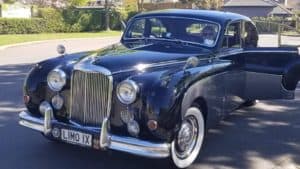
Jaguar XJS Review: A Cult Classic Cat
Share With Friends:
By Ben Selby
In the music industry, sometimes a band will release an album which absolutely blows everyone away. Whether its something totally unique or it captures the essence of the time in which it was released, sometimes a great album is capable of changing the way we look at popular culture. The same can be said of cars, particularly the Jaguar E Type.
Jaguar boss, Sir William Lyons wasn’t completely sold on the prototype of the new road going race car that was the 150mph E Type. He wasn’t entirely convinced it would be a big seller. But Lyons was forced to eat his own words, for when the E Type was unveiled at the Geneva Motor show in March 1961, people went wild for this most beautiful of cats.
Jaguar had hit big with their E Type “album”, but like all producers of popular music, you need to follow up this success with another great ‘follow up’ album.

Fast forward to 1975, the last E Type rolls off the Coventry assembly line and its successor begins production. Enter the XJS, a car which divided the Jaguar faithful like nothing before it. Some loved its styling and others ran a mile.
Development of the XJS began as early as 1968. Project XJ27 was headed by legendary Jaguar aerodynamicist Malcom Sayer, the same chap who made the D Type cars of Le Mans fame as slippery as possible. After Sayer’s death in 1970, the project was brought in house by Jaguar’s design team.

With its long bonnet and wide stance, the XJS was textbook coupe, however its swooping rear buttresses were the tell-tale signs of a car originally intended to be mid-engined.
However, the more traditional front engine, rear drive grand tourer layout was chosen, with the XJS’s grunt courtesy of a hefty 5.3L V12 producing 220kW of grunt. A top whack of 230km/h was guaranteed and zero to 100km/h in a brisk for the time, 7.6 seconds.
The first generation XJS saw production from 1975 to 1981. The response from fans was mixed, some were horrified at the successor to the truly beautiful and much-loved E Type, while others looked at the XJS as being very forward thinking in terms of design. The XJS also got time on the silver screen as the wheels of choice for Ian Ogilvy as TV special agent Simon Templar in ITC’s ‘Return of the Saint.’

In 1981, the XJS was give a refreshed and from 1983, was offered with a choice of two engines. The Olympian V12 remained, but joining it was a 3.6L straight six. The car you see here is one of the those with the six. Called the XJS HE, it was designed to be a more affordable way into XJS ownership, and was manual only from 1983 to 1987.
Power was rated at 165kW with peak torque achieved at 325Nm. The manual box was a Getrag five speed with drive going to the rear, of course. The HE was also offered as a convertible for the first time, though rag top buyers had to sacrifice the 2+2 seating practicality of the coupe.

This example is one of the nicest XJS’ I have seen in a long time. The styling has actually got better with age I reckon. Those rear buttresses, long bonnet and low and wide stance has really stood the test of time.
Inside, it is literally like entering the lounge of a 19th century stately home. Leather, leather, wood and more leather. The door shuts with a heavy dignified clunk.

The XJS is certainly no lightweight and is certainly a statement. All the switchgear screams 1980s and the simple white on black dials are devoid of any fripperies or additives. This example even has the original Jaguar Clarion stereo.
Ahead of you sits that classic black teering wheel with that snarling Jaguar staring at you, almost as if to say, “Go on, let er rip.” So that’s exactly what I chose to do. That said, a rip is probably not really what the XJS is about.

At slow speeds, the XJS makes no bones about being one of the most comfortable classic cars around. Those leather seats provide ample support but aren’t buttock-hugging buckets by any means.
You are left to slob out a bit with your arms out stretched. It is very much like sitting in a leather arm chair. In fact, a smoking jacket and leather patch on the armrest for your elbow would suit an XJS.

Ride comfort? Well that is just perfect. The XJS was a seriously competitive racing car, especially after being breathed on by Tom Walkinshaw Racing. However, its appeal is more of a sedate eater of miles, and the suspension and damping some of the softest and most soothing of any classic car.
I would go so far as to say the XJS is more comfortable than a number of modern luxury cars. Not bad for car which is approaching 40 years old. The bumps just aren’t an issue, you might feel a slight nudge while traversing loose bitumen, but that’s it. It just takes it all in its stride.

When you plant boot in the XJS, there is no instant response, but more a gradual opening of the taps. An XJS is not about blinding speed, but power under control. That six-cylinder engine is silky smooth.
There is a distinctive six pot engine note, but it is somewhat subdued, almost in the background. Some may hanker after the V12, but the big six is still just as refined and smooth enough for most of us.
On the motorway, you can flex your big toe an eighth of an inch and that long bonnet which seams to stretch to the horizon rises. Pretty soon, you are wafting along in great comfort and refinement.

Shifting cogs is also a delight, despite the gear lever being a long throw from gear to gear. It is light and responsive. Heck, you could even shift with one finger should you want to.
The steering is light and somewhat devoid of feedback. However, this is to be expected as this XJS is about the effortless cruise. Munching up bendy bitumen at speed is not really its bag.
It is a heavy car, and it feels it. But, you feel planted and stable at speed or in the corners, though cornering hard due to the soft damping is probably best left to those with a TWR badge. The XJS continued in production until 1996 when it was finally replaced by the XK8.
I can see why some don’t rate the XJS. The softness of the ride, the gradual build-up of power, and the lashings of leather and wood are not everyone’s cup of tea. However, for those who want to waft along in a statement of a car, in no particular hurry, will love the XJS. Also, with prices having bottomed out a few years back, its highly likely this cult classic cat will command top dollar in years to come.

It is as British as a steak and kidney pie and a pint of ale, the motoring equivalent of Edward Fox, and today, I think its still pretty cool. Jaguar’s follow up album just gets better with age.





